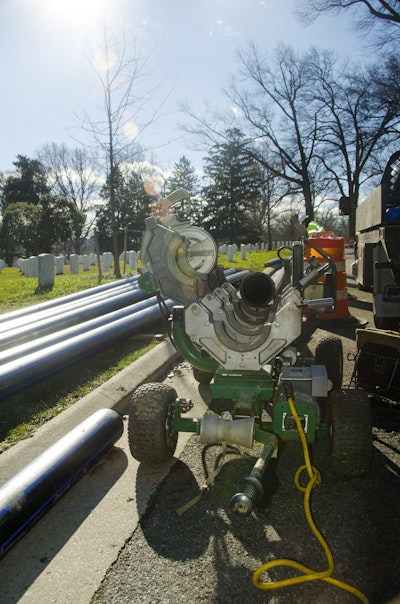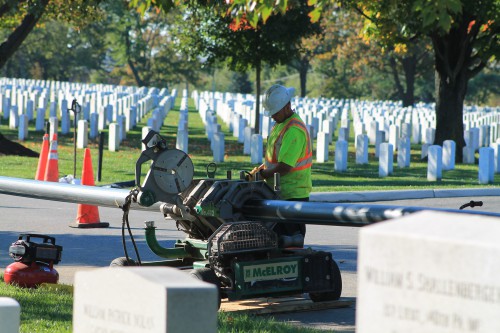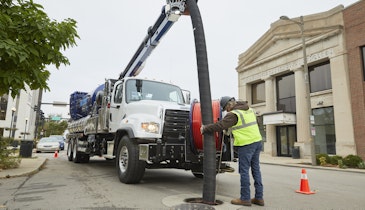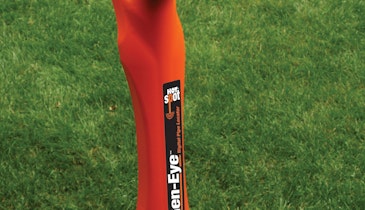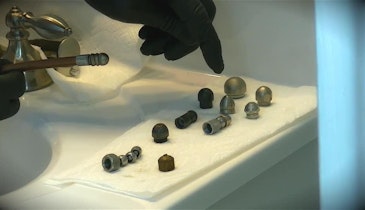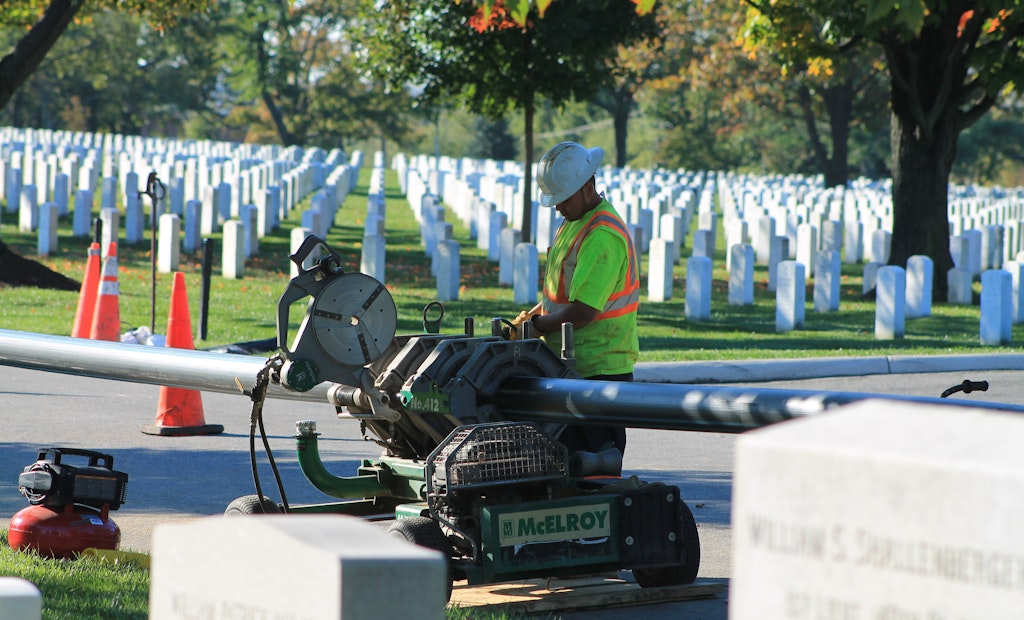
Interested in Municipal/Industrial?
Get Municipal/Industrial articles, news and videos right in your inbox! Sign up now.
Municipal/Industrial + Get AlertsAt the beginning of the Civil War, Union soldiers occupied Arlington, Virginia, realizing that the location offered a great strategic location, just across the Potomac River from Washington D.C. When the Union started taking large amounts of casualties during the war, the Army Quartermaster General ordered an examination of possible sites for military cemeteries.
Personnel soon came back with a viable option in Arlington, at the former home of Confederate General Robert E. Lee. The first soldier was buried on the site in May 1864 and over the years it has grown to 624 acres with more than 400,000 graves.
Naturally, as the cemetery and national park grew more sophisticated, an underground infrastructure was constructed to support the needs of the cemetery. More than 60 years ago, a series of cast iron water mains were installed for fire suppression and potable water uses on the site.
Quick facts
Location: Arlington, Virginia
Owner: U.S. Army
Designers: U.S. Army Corps of Engineers Norfolk District
Contractor: Murphy Pipeline Contractors
Manufacturers: TT Technologies, ISCO Industries, McElroy
Cost: $7.6 million
Size: 38,500 feet of pipe
The water pipelines on site snake around the 70 sections of the cemetery, as well as up and down the hillside that made the Arlington site such a strategic high-ground position in the Civil War.
Like much of America’s water infrastructure, it was determined recently that the park needed an upgrade to the water piping system. Arlington National Cemetery had suffered several breaks that had caused severe disruption.
After assessing different installation solutions to rehabilitate the old mains, the U.S. Army Corp of Engineers Norfolk District determined that the most efficient and effective way to install a new high-density polyethylene (HDPE) pipe system would be to use pre-chlorinated pipe bursting.
“Early on other methods were considered, but were eliminated,” says Todd Grafenauer, educational director of Murphy Pipeline. “Open cut would require large excavators and dump trucks, excavations and noise. Directional drilling would require the use of a new easement, which was challenging to identify due to the unknowns of what was underneath the surface because of the age of the cemetery.”
Pre-chlorinated pipe bursting is a preferred method for replacing waterlines that have exceeded their useful life. The replacement process spares the ground above the installation from being disturbed. The cost-effectiveness is impressive when installing under streets, sidewalks, mature landscaping, trees, or in this case, a national landmark and cemetery.
“Pre-chlorinated pipe bursting was chosen because of the reduction in excavation and speed of installation,” says Grafenauer. “Other factors included the reduction in noise due to the setting and reduction in surface displacement.”
The noise was reduced by the use of small excavators and one dump truck, when needed. Grass areas in the park were not disrupted, as they would have been with large excavators. Pre-chlorinated pipe bursting resulted in 87 percent less digging versus open-cut methods.
The benefits of pre-chlorinated pipe bursting don't stop at just the installation ease. Engineering design hours are reduced because alternate routes for the utility replacement aren’t needed. In the case of Arlington National Cemetery, many hours of work researching the grounds and area underneath it would have been needed. The mature trees and landmarks of the park were not affected, and the dust and other outputs of construction were minimized, leaving the park beautiful and prestigious for visitors.
Staging for pre-chlorinated pipe bursting
The process starts in staging areas, where 40-foot lengths of pipe are fused together using butt fusion. The butt fusion process to join HDPE pipe begins with the simultaneous “facing” or shaving of the pipe ends. The prepared pipe ends are then put in contact with a hot plate or heater. The time spent in contact with the heater creates a molten state on both of the pipe ends. After the heater is removed, the pipe ends are pressed together under a controlled force to form a weld that is as strong as or stronger than the pipe itself. Third-party research indicates that HDPE pipelines can have a lifespan of more than 100 years.
At Arlington National Cemetery, workers from Murphy Pipeline used a McElroy Rolling 28 fusion machine to fuse the 6-inch DIPS DR 11 Driscoplex HDPE pipe. The Rolling 28 is capable of fusing thermoplastic pipe from 2-inch IPS to 8-inch DIPS. Sizes smaller than 8-inch DIPS are fused by applying jaw inserts to reduce the inner diameter of the four jaws of the fusion machine.
Murphy Pipeline chooses McElroy fusion machines because of their quality and reliability. They also take advantage of McElroy’s productivity tools which help expedite the fusion process and protect their large fusion machine fleet.
“We use the McElroy Pipe Stands extensively,” says Andy Mayer, president of Murphy Pipeline. “They allow the pipe to be brought into the fusion machine at a consistent level for a more efficient fusion process. They also reduce stresses on the pipe rollers and the machine itself.”
Once the 300- to 600-foot lengths of pipeline were fused together, Murphy Pipeline workers capped the pipe ends. Each pipe section is then bacteriologically disinfected and pressure tested in the staging area prior to installation. Two consecutive days of samples are taken, each 24 hours apart, and checked for bacteriological clearance. This step is critical, as it is what eliminates alternative or temporary water services to be set up. Because the pipe has been properly pre-chlorinated, it is ready to be put into service immediately after installation.
Murphy Pipeline takes great care in the quality of its installations. The final component of the staging process is the addition of a manifest attached to each pipe section that identifies the testing results and that the steps have been taken. Records of the testing are given to inspectors, project managers and project owners.
Static pipe bursting process
To install the replacement piping, workers excavated small entry and exit pits in the cemetery. The original cast iron main was decommissioned and readied for the pipe bursting process as equipment was lowered in the pits.
Long metal rods travelled through the existing main to the launch pit, where a blade set, expander, tracing wire and HDPE piping are attached to the rods. Once all equipment was in place, the pull-back process began. In most cases, the pipe was pulled back and burst through the old pipe by the early afternoon.
The static pipe bursting process can also be used to replace existing mains made of AC, PVC, ductile iron, clay, concrete and steel.
During the pull, the expander forced the existing cast iron mains to split and the pieces of the old pipes were pushed into the surrounding soil. The new HDPE pipe was then pulled through the space created by the expander.
On the days spent pipe bursting, crews could often be found making connections in the early afternoon. Lastly pits were backfilled as the pipelines were put back into service.
Challenge of mobility
Murphy Pipeline personnel were challenged with working in an operational national landmark that would not be closing to tourists and visitors, averaging 11,000 per day. Arlington National Cemetery also holds, on average, about 25 to 30 funerals per day. Inevitably, these funerals would occur near construction areas. Out of respect to the deceased and the services, workers often had to stop fusing and work elsewhere during the funeral.
Workers were able to load up the fusion machine quickly, taking it to and from location on the back of a flat-bed truck. Workers could unload the machine, a small generator, and be fusing pipe as soon as the heater came up to temperature. Tear down of a site — for funeral purposes or after completion — was also simple and required minimal effort.
Project length
In total, five construction phases progressed replacing over 38,500 feet of existing 6-inch cast iron water main with new 6-inch HDPE. Murphy Pipeline Contractors was awarded the phases through Patriot Construction, 8(A), SDVOSB, a full services general contractor, headquartered in Maryland.
“The project progressed without incident and is a true testimony to the pre-chlorinated pipe bursting technology and the team atmosphere to replace the extensive water main system with little to no impact on the cemetery and its daily activity,” says Mayer. “Teamwork was vital to ensure a successful project. The Norfolk District U.S. Army Corps of Engineers and Arlington National Cemetery personnel showed great resolve in working with our crews to properly plan, adapt and execute the project.”
Author Tyler Henning was a public relations specialist with McElroy Manufacturing, Inc.
